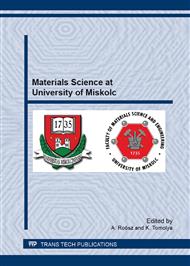p.193
p.201
p.209
p.217
p.225
p.233
p.241
p.248
p.259
Preparation and Evaluation of Novell Wood-PVC Systems
Abstract:
To protect the environment and conserve resources WPC (Wood-Plastic-Composite) materials are gaining foothold. Since in the construction industry both PVC (high weathering resistance, flame retardant, lightweight, long lifetime) and wood (natural, decorative, renewable) are well known and liked materials wood-PVC composites are also sought for. Numerous research and development/improvement efforts are on the way to produce commercially successful systems. The main hindrance is the compatibility issue between the components. This work describes a novel method – a work in progress – applied for a selected wood type, which was processed and validated using physical and mechanical tests. It was found that the prepared composite system is somewhat softer and more flexible than the original matrix PVC composition, but the thermal stability and the application temperature has been improved. It was also found that the PVC encloses the wood particles, shielding them from the environment and the humidity, thus protecting it from mold and microorganisms eve in humid conditions. A further step in the work is performing the tests focusing on the processing behavior of the material.
Info:
Periodical:
Pages:
225-232
Citation:
Online since:
March 2013
Authors:
Keywords:
Price:
Сopyright:
© 2013 Trans Tech Publications Ltd. All Rights Reserved
Share:
Citation:


